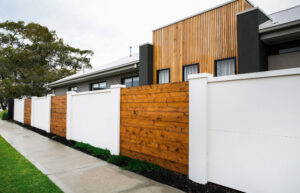A boundary wall does much more than mark the physical property line. It sends a message to the world that your property is off-limits to trespassers and others. For more information about boundary walls just visit Website.
Boundary walls must be built properly or maintained to have major structural problems over time. They may even start retaining soil and function as a retaining wall for which they were not designed.
 A boundary wall can be a great way to add aesthetic value to your property. It can be designed in various styles and materials, but choosing a wall design that complements the style of your home and surrounding landscape is important. It is also important to consider local council regulations when choosing a front and boundary wall design. These may include restrictions on wall height, materials, or specific design elements.
A boundary wall can be a great way to add aesthetic value to your property. It can be designed in various styles and materials, but choosing a wall design that complements the style of your home and surrounding landscape is important. It is also important to consider local council regulations when choosing a front and boundary wall design. These may include restrictions on wall height, materials, or specific design elements.
Boundary walls can be constructed from various materials, including concrete, bricks, and stone. Each material has its advantages and disadvantages. Some materials are more durable than others, and some require less maintenance. A good landscaping company can advise you on your property’s best boundary wall material.
Besides the aesthetic value of a boundary wall, it can also protect against weather and wildlife. Often, these walls are designed with a combination of textures to create a unique visual effect. For example, a wall can look rough and rugged by adding rock panels or using a mixture of smooth and textured stones.
Another option for enhancing the appearance of a boundary wall is to add decorative features. These can range from simple garden ornaments to wrought iron fences. They can even be used to frame entrances and driveways. It is also a good idea to plant colorful flowers along the wall, as this can help to make it more attractive.
A boundary wall should be built to a high standard. If it is not, it will crack and deteriorate over time. It is also important to ensure that the wall is waterproofed. Otherwise, water will soak into the batako and cause dampness and mold.
A boundary wall can be painted in various colors and styles to make your property stand out. It can be decorated with a unique pattern or topped with an ornamental gate to create a more appealing appearance. In addition, a boundary wall can be clad in stone to enhance its appearance and offer additional security.
Boundary walls protect your property from animals, thieves, and other intruders. They can also help you maintain a good relationship with your neighbors. Boundary walls demarcate property lines and provide a buffer against noise. However, boundary fences can cause problems if they’re not built correctly. If you need help with how to construct a boundary wall, you should consult with a professional. The erecting of a boundary wall requires permission from your local council. If you build a boundary fence without a permit, you could face fines and penalties.
Generally, the boundary wall should align with the property’s cadastral boundary. It should also be constructed of durable materials resistant to weathering and corrosion. It should be designed to resist lateral pressure and withstand the weight of vehicles or pedestrians. In addition, it should be prepared to ensure the stability of the soils on which it is erected.
A boundary wall is a non-load-bearing structure erected to demarcate site boundaries and act as a physical barrier. It can be constructed from various materials, including concrete, bricks, stones, aggregate, metal panels, wooden panels, or polyvinyl chloride fancy, often known as PVC fences. The height of a standard boundary wall ranges from 4ft to 8ft or 1m to 2.4m.
The concept of privacy varies widely among individuals and societies. Some theorists argue that privacy is a fundamental human right. Others believe that privacy is a socially negotiated concept. In these cases, people may share the same values but have different views on privacy.
Boundary walls are an important feature of a home. They can provide a sense of security, limit scenic vistas, and protect against noise pollution. Modern designs lean towards green walls covered in plants and modular fences that can be reshaped. They can also be fitted with sensors and cameras for increased safety. These walls are becoming increasingly popular in urban settings, where they can be used to control traffic flow and reduce noise levels.
A boundary wall is a great way to improve your home’s security by deterring trespassers. It also provides a sense of privacy and exclusivity. Boundary walls are available in many different shapes and styles so that you can find the right one for your property. A unique design can add character and make your home more attractive.
A good boundary wall should be strong and durable, made of sturdy materials that can withstand the elements and resist rusting. It should also have safety features, such as anti-climb measures and spikes. Suppose you’re planning to build a boundary wall. In that case, it’s important to consult with an experienced contractor who can assess your soil conditions and recommend the best construction method for your project.
Boundary walls can be built from various materials, including bricks, concrete, sand, aggregate, stone, and metal panels. They can also be made from wood or a combination of these materials. The material you choose should be durable and aesthetically pleasing, but it’s also important to consider the cost of your boundary wall.
To keep your boundary walls safe, you should inspect them regularly for signs of damage. If you see any cracks or holes, it’s important to repair them as soon as possible. A damaged boundary wall can easily fall, which could cause serious damage to your property and injury to anyone who may be caught inside.
The height of a boundary wall can affect its safety. A taller wall is more likely to deter intruders, but it should be a safe height according to local regulations and not obstruct the view of traffic or pedestrians. Also, choose a boundary wall made of sturdy and durable materials, such as brick or concrete, and designed with safety features.
The structure of a boundary wall can be enhanced by adding unique elements such as lighting, water features, and plants. You can even opt for a mural or sculpture to make your home more appealing and distinguish it from its neighbors. A unique boundary wall can also help you stand out, boosting your property’s value and increasing its appeal to potential buyers.
Boundary walls are a great insulator against noise from neighboring properties and traffic. However, the effectiveness of such walls depends on how they are designed. The concrete density and the acoustic content of the material used to build the wall contribute significantly to its noise reduction capabilities. However, diffraction is equally important in the efficacy of sound barriers. Diffraction refers to how sound waves bend around corners and over barriers.
It is important to use dense materials with a smooth surface to prevent sound from bouncing off the barrier and traveling further into the distance. In addition to this, porous materials are also helpful in mitigating noise. Such barriers absorb sound instead of merely reflecting it toward the source.
The best materials for building sound barriers include stone and concrete. These materials have a high STC (tough transmission class) rating and effectively reduce ambient noise. They are also durable and require little maintenance. They are, however, more visually appealing than other materials.
Another type of boundary wall is a wooden one. Wooden boundaries offer privacy and security in different settings. They are also relatively affordable. However, they may be more susceptible to weathering and require regular maintenance.
A metal or steel boundary wall is a durable and visually appealing option that offers good security for your property. It is also a great option for people living near busy roads or airports. A metal or steel fence can be built to match the design of your house. It can also be customized with different features.
If you’re planning to have a boundary wall constructed, consult with your neighbors about the location of the wall and its appearance. You can appoint a surveyor to help settle the dispute without agreement. Additionally, if the integrity of the boundary wall is compromised, both property owners are liable to contribute to the repair costs. If your neighbor fails to fulfill this obligation, you can seek a court order to resolve the matter.


 Site Preparation
Site Preparation